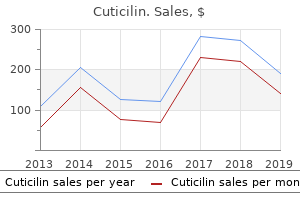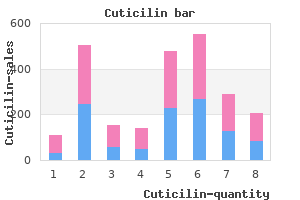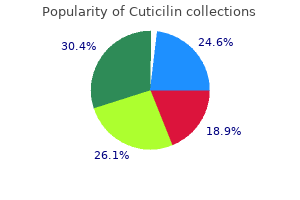

 5100 Springfield St. Suite 108, Dayton, Ohio 45431-1274
5100 Springfield St. Suite 108, Dayton, Ohio 45431-1274Cuticilin
"Purchase 5mg cuticilin overnight delivery, acne chart".
By: L. Hurit, M.A., Ph.D.
Program Director, Lincoln Memorial University DeBusk College of Osteopathic Medicine
Summation and Recruitment Under normal circumstances skin care 40 year old purchase discount cuticilin line, enough Ca2+ is released by a single muscle action potential to completely saturate all the troponin-C binding sites skin care talk discount cuticilin online amex. This means that all available cross-bridges are activated and thus force cannot be enhanced by increasing cytosolic Ca2+ acne when pregnant order cuticilin 40 mg on line. Instead, peak force in skeletal muscle is increased in 2 ways: summation and recruitment. Summation of Individual Twitches and Fusion into Tetanus and Fusion into Tetanus Recall Question Which of the following is the mechanism of action of rigor mortis Cytosolic calcium rises and binds to troponin-C, exposing myosin-binding site on actin C. The figure above Pathology Behavioral Science/Social Sciences illustrates that the twitch tension is already falling (muscle starting to relax) while the action potential is still in the absolute refractory period. Thus, a second action potential cannot be evoked before the mechanical event is almost completed. Depolarization opens these channels, resulting in calcium influx into the cytosol. Smooth Muscle Cell 66 Skeletal Muscle Mechanics 2 Learning Objectives Use knowledge of overview of muscle mechanics Interpret scenarios on length-tension curves Use knowledge of relationship between velocity and load Demonstrate understanding of properties of white vs. The graphs that follow are all generated from skeletal muscle in vitro, but the information can be applied to both skeletal muscle and heart muscle in vivo. Pathology Behavioral Science/Social Sciences Microbiology Passive Tension Curve As seen in the figure below, the green line shows that muscle behaves like a rubber band. The elastic properties of the muscle resist this stretch and the resulting tension is recorded. There is a direct (non-linear) relationship between the degree of stretch and the passive tension created that resists this stretch. Recall that active tension represents the force generated by cross-bridge cycling. The magnitude of active tension depends on the number of actin-myosin cross-bridges that can form (directly related). Increasing afterload decreases velocity, and when afterload exceeds the maximum force generated by the muscle, shortening does not occur (isometric contraction). The absolute amount of force is directly related to muscle mass and preload, with the greatest force occurring when the preload is at Lo.

Development of the University of Pennsylvania Smell Identification Test: a standardized microencapsulated test of olfactory function skin care gadgets buy genuine cuticilin online. Optical recordings from the human nasal mucosa in response to olfactory stimulation acne keloidalis cure purchase cuticilin 40mg online. Taste disorders in acute stroke: a prospective observational study on taste disorders in 102 stroke patients skin care for rosacea 5mg cuticilin sale. For information regarding the objective assessment of other nasal functions, see Chapter 2 regarding mucociliary clearance, and Chapter 4 regarding olfaction. Patient Selection and Indications for Testing Candidates for nasal airway testing include patients who have nasal obstruction, or those in whom nasal airway pathology is suspected of contributing to other conditions such as sleep disordered breathing, voice problems, or allergy. Like any test, nasal airway testing should be used in those cases in which it can reveal information that may change the course of action taken for a given patient. Objective assessment can be particularly helpful when the clinician is faced with conflicting information. Objective testing can also yield an accurate objective measure of changes from medical or surgical therapy and thus can be a useful tool to monitor the progress of therapy. Endoscopy has the advantage of seeing into parts of the nasal airway that may not be visualized with a headlight and a speculum and may reveal polyps or other pathology. The scope may also be used to visualize the area of the internal valve without any distortion from retraction by the nasal speculum. There are some maneuvers that can be performed as part of the physical examination that can help to elucidate the nature of the nasal obstruction. Alternatively, the internal and external nasal valve area can be gently widened with a wax curette. These tests require subjective appraisal by the patient and clinician and thus their effects are not easy to quantify objectively. Types of Objective Testing of Nasal Function Over a century ago, methods used for the objective assessment of the nasal airway included breathing on a mirror or glass plate (rhinohygrometry), assessing the sound of a forced expiration through the nose, and evaluating the pitch of the sound made by a patient humming while first one and then the other side of the nose was occluded. By the mid-20th century, rhinomanometry was used to measure transnasal pressure and flow. Starting in the late 1970s, the computerization of airway testing allowed for simultaneous storage, calculation, analysis, and printing of test results. Because of its relative ease of use, it became the more widespread method for objective nasal airway assessment in some countries. Today, the most commonly used tests are rhinomanometry, peak flow, and acoustic rhinometry. Rhinomanometry measures the actual continuum of airflow that results from the increasing and decreasing transnasal pressures that occur in the course of respiration. Rhinomanometry, when Diagnostic Workup of the Symptoms of Nasal Obstruction History the patient is asked specifically about the side of obstruction, severity, frequency, duration, exacerbating factors, and maneuvers that can improve nasal breathing. It does not yield the corresponding pressure needed to generate the measured flow. Acoustic rhinometry uses sound waves to measure the cross-sectional area of the nasal airway rather than the actual movement of air through the nasal passage. It has the advantage of being somewhat easier for some technicians to perform than rhinomanometry and of giving a distance to areas of maximal narrowing. Acoustic rhinometric measurements yield an area distance display that allows the measurement of the smallest cross-sectional area for the anatomic presentation of the sound wave from the instrument and yields the distance to that narrowest area. The reproducibility of the results obtained from any method of objective assessment of the nasal airway can be affected by the nasal cycle, secretions in the nose, exertion close to the time of testing (can increase airway dimension), temperature (cold air can reduce the airway), hyperventilation (can increase the airway), time of day (the airway can be less open at night and in the early morning), and the use of certain medications. Some have found an increase in the airway with increase in height, with increasing age in children, and in the elderly. In light of these variables, patients should avoid exercise and exposure to climatic extremes for 30 minutes before testing.
Purchase cuticilin 5 mg. Why Do Korean Girls Look So Young? | Korean Anti Aging Skin Care Tips | Wishtrend TV.

Painful sensations do result from excessive stretch acne red marks purchase genuine cuticilin online, violent or spasmodic contractions skin care vietnam discount cuticilin 30 mg, or decreased blood supply (ischemia) acne and diet generic cuticilin 10 mg without prescription. In such conditions, the pain may be felt in the region of the organ itself (true visceral pain) or in a cutaneous or even other somatic tissue region (referred pain). Referred Pain In pathologic conditions, visceral pain radiates to cutaneous areas and is therefore assumed by the patient to arise mainly or exclusively in surface areas of the body. It is important to recall that most visceral pain fibers travel with sympathetic nerves and reach the thoracic and upper lumbar spinal nerves through the 14 or 15 pairs of white rami communicating with the sympathetic trunks. Although the region to which the pain is referred may seem unrelated to the pathologic visceral organ, the two loci are part of the same segmental level. The commonly accepted explanation for referred pain is that within the spinal gray matter, the visceral afferent impulses converge on secondary somatic afferent neurons. Thus, an abnormally large volley of visceral afferent impulses causes spinothalamic neurons to fire, resulting in deception of the cerebral cortex. Clinical Connection Pain of visceral origin is not necessarily confined to visceral pathways in its conduction to the spinal cord, because the abdominal wall or the diaphragm may be involved by the disease process. Thus, pain of inoperable carcinoma of the stomach may not be favorably affected by sympathectomy (removal of the sympathetic trunks) because the body wall may be involved. Testis and kidney 4 5 6 7 9 8 Figure 19-7 Common cutaneous areas of referred pain. Chapter 19 the Autonomic Nervous System: Visceral Abnormalities 251 3 2 1 4 9 11 1. Spinothalamic tract 7 10 8 6 5 Figure 19-8 Schematic diagram showing the anatomic basis for visceral referred pain. The autonomic or visceral responses elicited by stimulation in the cerebral hemispheres are funneled through the hypothalamus, the highest center for the regulation of autonomic responses. In addition to hypothalamic nuclei, other groups of neurons at various levels also strongly influence autonomic activities. In the midbrain, pupillary constriction and lens accommodation centers are located at the levels of the pretectal area and superior colliculus. In the pons, a micturition center rostrally governs the initiation of urination, and pneumotaxic and apneustic centers more caudally influence respiration. Within the medulla are the cardiovascular and the expiratory and inspiratory respiratory centers. Although these various centers receive input from many sources (hypothalamus, cranial nerves, ascending pathways, and so forth), their output is funneled to autonomic efferent and, in many cases, associated somatic neurons (Table 19-3). Examples of such connections are those that control the heart, the urinary bladder, and the sex organs. Control of the Heart the heart is abundantly supplied by parasympathetic, sympathetic, and afferent nerves. Chapter 19 the Autonomic Nervous System: Visceral Abnormalities 253 Visceral afferent impulses arising from the heart travel centrally via the vagus and sympathetic nerves. The cardiac vagal afferent fibers enter the solitary tract and synapse in the solitary nucleus. The cardiac afferent fibers traveling via the sympathetic nerves do so on the left side. Their cell bodies are located in the upper four or five thoracic dorsal root ganglia, and they synapse in the upper thoracic spinal cord segments. These control centers are influenced mainly by impulses descending from the hypothalamus and by visceral afferent impulses from mechanoreceptors and chemoreceptors located in the walls of the heart, aorta, and carotid arteries. The mechanoreceptors or baroreceptors respond to blood pressure; the chemoreceptors respond to oxygen and carbon dioxide levels in the circulating blood.

Modulation of inflammation skin care specialist buy cuticilin 40 mg amex, wound healing acne icd 10 effective 10mg cuticilin, and tissue regeneration are areas of active work in biomaterials acne with pus buy cuticilin overnight delivery. These potential uses of biomaterials also impact rhinology and a large number of biomaterials have been used in the nose and sinuses. They have been used to repair frontal sinus and skull base defects, control epistaxis, and prevent scarring and adhesions following sinus surgery. An ideal biomaterial would prevent scarring and middle turbinate adhesions, inhibit ostial stenosis, promote epithelial healing and return to normal functioning, and diminish inflammation. Reduction of perioperative bleeding through platelet scaffolding or coagulation activation would be an added advantage. Sustained delivery of pharmacotherapeutic agents would further enhance the effectiveness of a rhinologic biomaterial. Gelatin is a common hemostatic that consists primarily of hydrolyzed collagen, produced by treating animal connective tissues with strong acids and bases at high temperatures. Derived from either bovine or porcine sources, it typically generates a foreign-body reaction when implanted in humans. Thrombin may be added to gelatin to improve conversion of fibrinogen to fibrin, thus combining the terminal effects of the clotting cascade with the platelet aggregating effect of the gelatin particles. Gelatin has been studied as a spacer and thrombingelatin paste has been studied in sinus surgery. Although there is little doubt about the efficacy of thrombin-gelatin paste in treating bleeding, its potential to promote scarring is more in question. The gelatin appears to enter the submucosal space and provokes a foreign body reaction or acts as a collagen bridge for scarring. Wound healing is a complex yet orderly sequence of events that involves a variety of cell types and subcellular signals. Inflammation is the first of the three phases of wound healing, followed by proliferation and remodeling. The inflammatory phase involves the influx of macrophages and other cells from the circulation and the subsequent release of modulators such as cytokines. Within a few days of the injury, a loose connective tissue matrix containing hyaluronan, fibronectin, and collagen is present. Inflammatory cells continue to provide signals that regulate the healing processes at this stage, such as angiogenesis, fibroplasia, and reepithelialization. The extracellular matrix changes, with hyaluronan and other glycosaminoglycans diminishing while elastin and proteoglycan deposition increases. Unlike epidermal injuries, where skin appendages provide the primary source for new epithelial cells, respiratory epithelium appears to regenerate mostly from 280 Rhinology scavenging reactive oxygen species and enhancing reepithelialization. In essence, all biomaterials, even two compositions derived from the same starting material, are not created equal. Chitosan has emerged as a material with promise both in diminishing mucosal scarring and as a platform for drug delivery in the sinuses. Theoretically, this replacement with bone would make radiologic detection of mucoceles much easier. With implantation often occurring in an infected/inflamed sinus, and the possibility of the material becoming exposed within the frontal recess, infection becomes a significant risk. Biomaterials, which can provide a sustained delivery of provascularization growth factors and defined porosity for vascular ingrowth, may prove to be a significant advantage in the future. Beyond diagnostic procedures, with modest equipment and supplies many interventions can take place in the office. These interventions include olfactory testing, allergy testing and management, epistaxis care, endoscopic biopsy and culture, preoperative and postoperative sinus care, inferior turbinate submucous resection, and even revision sinus surgery, balloon dilation, and polypectomy.